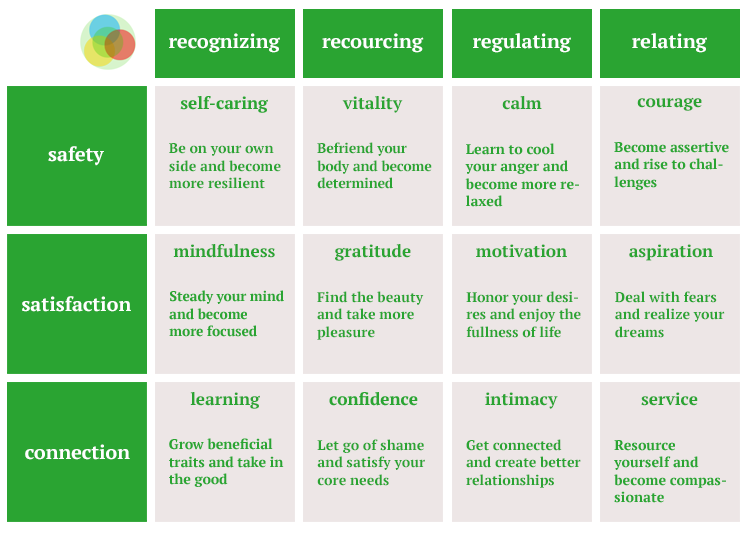Can 12 ideas be described as constituting pillars of well-being? Ed Gould examines the ideas of leading psychologist Rick Hanson that can help you optimize your happiness.
An expert in his field and creator of the 12 pillars of well-being, Rick Hanson is the author of several books on happiness and well-being. In Hardwiring Happiness, for example, the eminent psychologist discusses how recent scientific studies have led to a greater understanding of the correlations between neural structures and mental well-being.
A senior fellow of the Greater Good Science Centre at University College Berkeley, Hanson's scientific ideas have featured in many news features around the world, such as with the BBC and CBS. He has spoken at Oxford, Stanford and Harvard universities, to name but a few.

Gratitude: one of the 12 pillars of well-being
However, Rick Hanson is probably best known as the founder of the Wellspring Institute for Neuroscience and Contemplative Wisdom, an institution that is centred on his idea of the 12 pillars of well-being. Along with his other best-selling publications, Just One Thing, Buddha's Brain and Mother Nature, Hanson produces a free newsletter that has over 100,000 subscribers. Throughout his published work and regular newsletters, Hanson's extensive career has been leading many to the 12 pillars of well-being concept.
What are the 12 pillars of well-being?
What is it that Rick Hanson can teach us about happiness and contentment and how do the 12 pillars of well-being help us to achieve them? Let's examine Rick Hanson's concept in the first place.
“Hanson's 12 pillars of well-being are designed to create a simple path that will enable you to grow a dozen strengths needed for better well-being.”
The first thing to note about the Rick Hanson model of well-being is that it is two-dimensional. This is not to say that it has no depth, rather that you can imagine the 12 pillars of well-being laid out on a grid. Across the top of the grid are the names of the “Four R's” which constitute the grid's four columns. According to Hanson, these represent the mainstays of well-being:
- Recognising
- Resourcing
- Regulating
- Relating
Running horizontally are three core needs we all have:
- Safety
- Satisfaction
- Connection
From either the core needs or from the category of well-being, it's then possible to get to each of the 12 pillars. For example, where Resourcing coincides with Connection, the pillar is named as “Confidence”. Alternatively, where Regulating and Safety intersect, the pillar would be “Calm”.
Because the 12 pillars of well-being are arranged, or, more accurately, can be thought of in this way, it's possible to truly understand which each one represents. “Mindfulness” and “Motivation” are both pillars that connect to the core need of Satisfaction, for example.
 The 12 Pillars of Well-Being: Dr Rick Hanson
The 12 Pillars of Well-Being: Dr Rick Hanson
How to use the 12 pillars of well-being
Hanson's 12 pillar concept is designed to create a simple path that will enable you to grow a dozen strengths needed for better well-being. However, they are not simply healthy habits to get into or new ways of thinking about the world. The pillars are designed to make alterations inside your brain so that you can get the most out of your life.
Primarily, Hanson is using the well-known medical phenomenon of neuroplasticity within each of our brains to reorganize neural networks. He's showing us how this can be done for improved mental and lifestyle outcomes. Much as someone who has suffered a brain injury will learn how to perform certain tasks using other parts of their cortex, so the 12 pillars of well-being can help us to rewire our brains for beneficial effects. How does this work?
“Hanson's pillars of happiness remind us that our neural networks need rewiring from several different angles at once to achieve a true equilibrium.”
You may already work on your self-development in particular ways. For example, you may have embarked on a programme of self-compassion by reaffirming positive things about yourself each day. Under Hanson's 12 pillar model, you are “Recognising” the core need of “Safety” by being self-caring in this way. Every time you go through a ritual of self-caring or take the time to compliment yourself, then you're reinforcing a neural structure at a physical level within the brain.
Equally, if you're working on scientifically-proven techniques to improve confidence, such as working on your support network more regularly, then Hanson's model would ascribe this to “Resourcing” your core need for “Connection”. However, these are just individual examples of rewiring neural networks. The point is that having the 12 pillars of well-being in place will help to make sure that you're not missing out on any single element.

Love yourself: self-care is one of the pillars of happiness
All too often, we identify a need for our inner well-being and focus on that. Although this is perfectly understandable and very human behaviour, it's not always the best route to overall mental well-being. Hanson's pillars of happiness remind us that our neural networks need rewiring from several different angles at once to achieve a true equilibrium. Indeed, he points out that 12 essential elements, or pillars, lie at the heart of improving ourselves, not just one or two.
Think of it regarding an athlete training for a competition. In this analogy, if they only work on one or two muscle groups, then they may find improved physical performance in some areas. However, if they neglect the other parts of their body, then they could find themselves going backwards in others.
RELATED:
- The Attitude of Gratitude: 6 Ways it Can Change Your Life
- 7 Mindfulness Tips For Staying Engaged
- Top 5 Benefits of Gratitude Practice
This is what Hanson is teaching us with the brain's need for 12 pillars to be fed at once, from mindfulness to gratitude, and from vitality to learning. As long as we work on each of our three core needs across the four mainstays of well-being, then each of the 12 pillars will contribute to a rewired brain that truly sets us on the path to greater enlightenment and better mental well-being.
Each pillar has a role to play
What's more, Hanson's 12 pillars of well-being gives us a good idea of how to work on each pillar. As just one example, if we look at the fifth pillar, gratitude, Hanson describes what needs to be done to heighten behaviours that relate to gratitude. He shows us how to take pleasure by releasing inhibitions and focusing on all of our sensory experiences, not just on one or two. Furthermore, under the fifth pillar, he teaches how to take pleasure from every day, even mundane, things.
Watch: The 12 Pillars of Well-Being with Dr Rick Hanson
Similar advice can be found for each pillar of life, such as developing a sense of 'unilateral virtue' and 'speaking from the heart' under the tenth pillar of courage. Taken together – and not in isolation from one another – each pillar offers a step on a wider path.
Like all journeys, each step forward marks progress but, crucially, will also lead to physical changes in our brains, as well. More information on each of the 12 pillars of well-being and some great instructional videos can be found at the Foundations of Well-Being. ●
Images: Colourbox.com, shutterstock/Julia Savalishina
Written by Ed Gould
 Ed Gould is a UK-based journalist and freelance writer. He's a practitioner of Reiki.
Ed Gould is a UK-based journalist and freelance writer. He's a practitioner of Reiki.
Join the conversation
You are posting as a guest. If you have an account, sign in now to post with your account.
There are no comments to display.